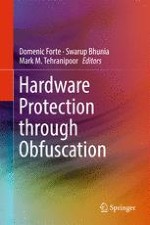2017 | OriginalPaper | Chapter
13. Obfuscation and Encryption for Securing Semiconductor Supply Chain
Authors : Ujjwal Guin, Mark M. Tehranipoor
Published in: Hardware Protection through Obfuscation
Publisher: Springer International Publishing
Activate our intelligent search to find suitable subject content or patents.
Select sections of text to find matching patents with Artificial Intelligence. powered by
Select sections of text to find additional relevant content using AI-assisted search. powered by
